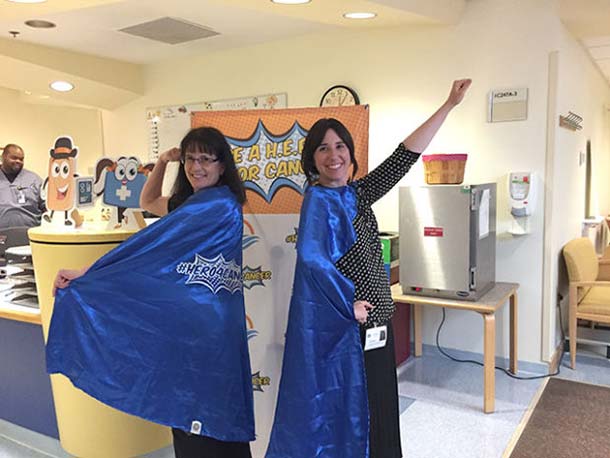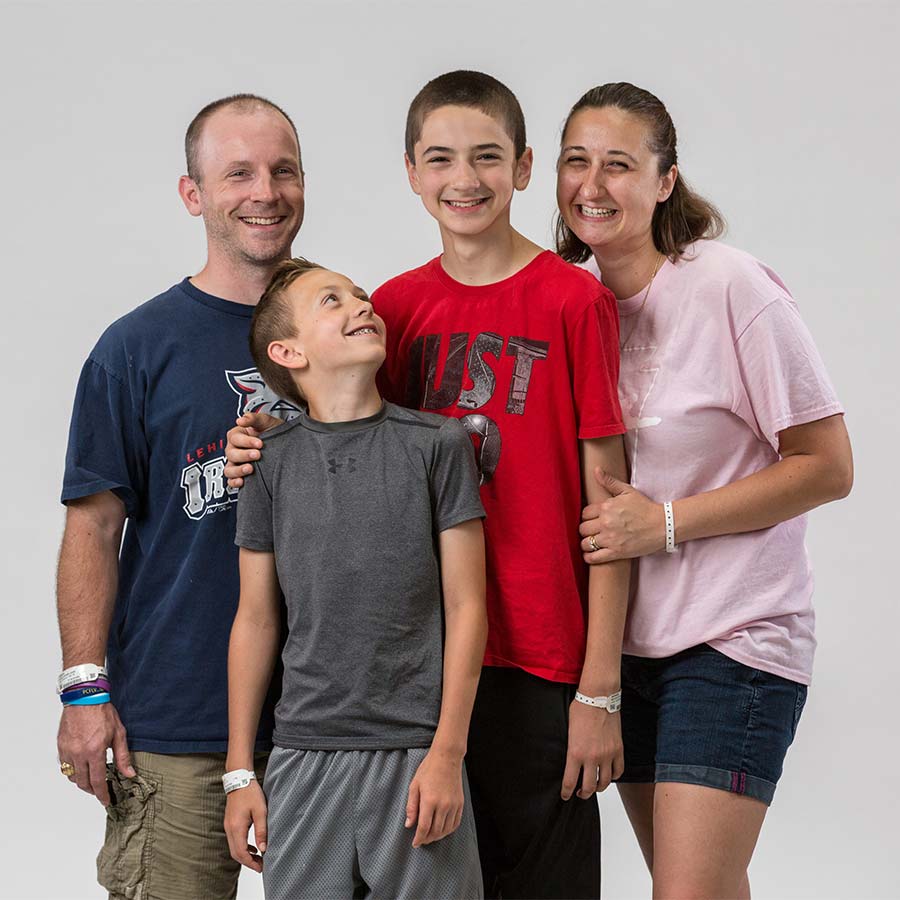
NCI’s Rare Cancer Clinics: Engaging Patients and Fostering Collaboration
February 28, 2019, by NCI Staff
Being diagnosed with any kind of cancer is frightening. Having a cancer so rare that only a few hundred people a year get such a diagnosis adds to that a sense of radical isolation.
When Becky Owens was 41 years old, she found out she had such a cancer, called wild-type gastrointestinal stromal tumor (GIST). Any type of GIST is already uncommon. Only about 5,000 people are diagnosed each year in the United States. Most have tumors with one of two gene mutations that can be successfully targeted with existing therapies.
Owens' GIST did not carry one of those mutations, in effect making it a different disease. Only about 10% of people with GIST fall into this category—many of whom receive their diagnosis as children—knocking it squarely into the ultra-rare disease zone.
“You feel like you’re the only one in the world who’s facing this,” Owens remembered thinking after receiving her diagnosis.
Researchers eventually named her type of GIST "wild-type" because it lacked the mutations found in most other GISTs. But over the last decade, an international group of scientists based at NCI has found that wild-type GIST has a distinct genetic cause of its own. And lessons learned by this team have not only changed the way this rare cancer is treated, they have also inspired similar efforts for other rare tumors, both in the United States and internationally.
Getting Everyone in One Place
If there’s an upside to wild-type GIST, it’s that it usually grows slowly and rarely spreads to other parts of the body. But it eventually can lead to pain, blockages in the stomach or intestines, bleeding, anemia, and other problems. And surgery to treat it used to involve taking out the entire stomach, which can greatly diminish a person’s quality of life.
The lack of good treatment options for wild-type GIST led people in the GIST research community to decide “that we have to help these patients who have no effective treatments,” said Sara Rothschild, a patient advocate with the Life Raft Group, a support and advocacy group for patients with GIST.
Researchers in NCI’s Pediatric Oncology Branch (POB), led by Lee Helman, M.D., then with NCI’s Center for Cancer Research (CCR) and now at the Children's Hospital Los Angeles, and Alberto Pappo, M.D., of St. Jude Children's Research Hospital, along with Norman Scherzer of the Life Raft Group, realized that any individual clinician would never see enough patients with wild-type GIST to collect the data needed to understand the disease. They would have to collaborate and get doctors and patients all in one place.
In 2008, they held the first NIH Pediatric and Wild-type GIST Clinic at the NIH Clinical Center in Bethesda, MD. The clinic brought together about a dozen pediatric patients and a diverse array of specialists who treat such patients. These specialists—from both NCI and outside—included surgeons, oncologists, hormone specialists, pathologists, imaging experts, counselors, and more, said Fernanda Arnaldez, M.D., of CCR, who currently leads the clinic.
Owens, now 59, was invited to attend the clinic in 2009 as an advocate with GIST Support International. The GIST clinics were initially held every 6 months but shifted to once a year in 2014. Several years after the clinic was launched, adults with wild-type GIST could participate, and Owens has attended as a patient twice since then. More than 160 patients in total have attended since the clinic’s inception, said Rothschild.
In addition to receiving counseling and expert advice on treatment from the doctors and researchers, patients have chances to meet with each other and discuss their experiences.
“When you have a rare cancer, it’s very meaningful to be able to connect to others in the same situation,” Owens said.
Connecting Dots and Changing Treatments
GIST clinic participants also donate tissue samples from their tumors. In the early days of the clinic, these samples quickly provided a big payoff. In only 3 years, researchers affiliated with the clinic used these tissue samples to pinpoint the genetic cause of GIST in most of these wild-type patients: mutations in a group of genes called SDH.
These SDH mutations are usually germline mutations—that is, they are inherited and can be found in every cell in the body. And the researchers figured out that inherited SDH mutations can put people at risk of other rare types of cancer, including kidney cancer and neuroendocrine tumors such as pheochromocytoma or paraganglioma.
This discovery was a lightbulb moment for many patients like Owens, who found out 3 years ago that she carried an SDHmutation. Her mother had suffered from—and eventually died of—a disease that, in the 1960s, doctors couldn’t identify. Her symptoms matched those now known to be caused by neuroendocrine tumors.
“It wasn’t until I was diagnosed, and they identified the SDH germline mutation and…started to connect the neuroendocrine component, that it all became very clear that my mother’s disease and mine are probably linked,” said Owens.
The GIST clinic now offers genetic testing for SDH mutations to all patients as well as interested family members.
Clinic researchers went on to find that other kinds of modifications related to the SDH genes, called epigenetic alterations, can also lead to GIST. This discovery led to an ongoing clinical trial at NIH testing a drug called guadecitabine, which targets one type of epigenetic modification.
Currently, no targeted therapies or chemotherapies have been shown to be effective in patients with wild-type GIST. But with a genetic culprit identified, researchers are now working to create cell lines and animal models of GIST with SDH mutations that could be used to test new drugs, said Karlyne M. Reilly, Ph.D., who leads the Rare Tumors Initiative in CCR.
Information from the clinic has greatly changed surgery for patients as well, said Dr. Arnaldez. Participating doctors saw that, for many people, surgery could be safely delayed for years, or even avoided completely. And when surgery was needed, it could be less aggressive than it had been in the past, such as removing less of the stomach or intestines, sparing young patients many serious side effects.
Expanding the Model
Over the years, the clinic has found ways to increase the number of patients who can participate. Since the clinic is now held only once a year, some of its specialists provide remote consultations to participants between meetings, with the facilitation of the Life Raft Group’s virtual tumor boards, Rothschild said. And the NIH Clinical Center’s new Natural History Study of Rare Solid Tumors allows people who can’t travel to the clinic to have samples of their tumor tissue sent in to contribute to the research effort.
The effort has also extended to other countries. The mother of a patient from the United Kingdom who traveled to attend the NIH clinic has since founded a companion effort in the UK, called PAWS-GIST. And the Life Raft Group recently launched the Pediatric & SDH-Deficient GIST Consortium as a platform for international collaboration.
In less than two decades, wild-type GIST has grown from an almost unknown disease to a model for rare tumor research, said Dr. Arnaldez. She recently received a phone call from an oncologist in California who suspected a patient of his might have the disease.
“I asked him how he found me, and he said that 'when I Googled "wild-type GIST," your clinic is what came up,'” she said.
The successes of the GIST clinic have encouraged NCI to expand the model to other rare tumor types.
“A wealth of knowledge was obtained by doing [the GIST clinic], so one of the thoughts we had was, could we apply this model to other rare tumors that are exceedingly difficult to study?” said POB Chief Brigitte Widemann, M.D.
In October 2018, Dr. Widemann, John Glod, M.D., of CCR, and other NCI researchers held the first clinic for medullary thyroid cancer. Like GIST, most medullary tumors respond to existing treatments and rarely come back. The new clinic is studying medullary tumors that don’t respond at all to standard treatments or do recur. Like wild-type GIST, these tumors may represent an even rarer cancer subtype that is yet to be identified.
And this April, Dr. Widemann and her team will launch the first clinic for pediatric chordoma, a rare type of bone cancer. One genetic driver of chordoma in adults has been identified, but what causes the disease in children is not well understood, explained Dr. Reilly.
The new clinic will include a collaboration with NCI’s Division of Cancer Epidemiology and Genetics (DCEG) to hunt for genetic risk factors for the disease in children.
Connecting with NCI about Rare Tumors
MyPART Rare Tumor Clinics:
NCICCRRareTumorClinic@mail.nih.gov
NCICCRRareTumorClinic@mail.nih.gov
Engaging a Broad Range of Patients
The new clinics are the first efforts of the My Pediatric, Adolescent, and Adult Rare Tumors Network (MyPART), funded by the Cancer Moonshot℠. MyPART is part of the Moonshot’s Rare Tumor Patient Engagement Network.
Another component of this network is a project called the NCI Comprehensive Oncology Network Evaluating Rare CNS Tumors (NCI-CONNECT). This new effort was inspired by NCI researchers’ experience with the Collaborative Ependymoma Research Network, which provided a model for a collaborative program to study rare cancers of the central nervous system, explained Mark Gilbert, M.D., chief of NIH’s Neuro-Oncology Branch.
While MyPART will continue to focus mostly on children and adolescents, NCI-CONNECT is studying 12 rare central nervous system cancers in adults. Some of these 12 tumor types are diagnosed in a few thousand people each year. Others are so rare that only a few dozen have ever been reported, explained Terri Armstrong, Ph.D., of CCR, co-lead investigator of NCI-CONNECT.
Patients come to the NCI-CONNECT clinic in person and can then either continue care with the NCI team or have them help coordinate their care at home. The nature of these tumors means the NCI-CONNECT clinics are structured differently than the GIST clinic by necessity, explained Dr. Armstrong.
“Most of these folks, if they’re newly diagnosed or if their tumors recur, they really need to get started on treatment quickly,” she said. “They can’t wait 6 to 12 months to see a specialist.”
Because of this urgency, the NCI-CONNECT clinics occur weekly. Still, the team tries to have people with the same tumor types attend on the same days whenever possible.
“Having the opportunity to share their story with other people [with their cancer] is something they talk about and really like, when we ask for their feedback,” said Marta Penas-Prado, M.D., the lead physician for the clinics.
Like those in the GIST clinic, NCI-CONNECT participants receive wellness resources and genetic counseling, in addition to treatment guidance. They also donate tissue for research on their cancer types. The research team has already used these samples to refine a test that has changed the diagnosis of more than 10% of the people referred to the Neuro-Oncology Branch. The team is also collaborating with DCEG researchers to look for genetic and environmental risk factors for these rare tumors.
The NCI-CONNECT team hopes that the information obtained by studying samples from patients will help them design clinical trials to test therapies that are tailored to the specific genetic drivers of these rare tumors, Dr. Penas-Prado explained.
These trials will initially be conducted at NCI. Once a therapy has proven to be safe, a given trial can then be rolled out nationwide through the Brain Tumor Trials Collaborative, a 34-center clinical trial network, enabling participants to be treated close to their homes.
“It’s really inspiring to see how much you can do with people—patients, advocates, care providers, researchers—from very different backgrounds coming together,” said Dr. Arnaldez. “And to be able to funnel all these discoveries … to populations that really need them is awesome.”























.png)










No hay comentarios:
Publicar un comentario